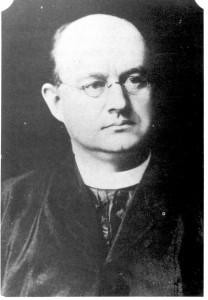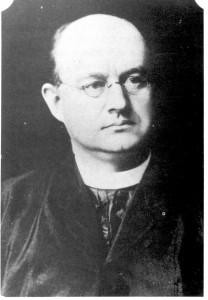Jozef Murgaš, vynálezca (1864 - 1929) priekopník bezdrôtovej telegrafie, rádia
Najdynamickejšie segmenty v oblasti komunikačných služieb sú dnes služby Internetu, mobilná telefónia a proces konvergencie hlasu a dát. Ak sa však vrátime o 110 rokov nazad do histórie uvidíme, že vývoj v tejto oblasti začínal bezdrôtovým prenosom informácií zakódovaných v ustálených telegrafných značkách a bezdrôtovým prenosom hlasu, ktorý bol vytvorený frekvenčnou moduláciou.
 Prvenstvo bezdrôtového prenosu informácií prostredníctvom elektro magnentických vľn určil Okresný súd v New Yorku dňa 7. Januára 1916 nášmu rodákovi Jozefovi Murgašovi, ktorý ho úspešne vykonal v roku 1905 medzi mestami Wilkes- Barre a Scranton v USA na vzdialenosť 20 míľ/30 km/
Prvenstvo bezdrôtového prenosu informácií prostredníctvom elektro magnentických vľn určil Okresný súd v New Yorku dňa 7. Januára 1916 nášmu rodákovi Jozefovi Murgašovi, ktorý ho úspešne vykonal v roku 1905 medzi mestami Wilkes- Barre a Scranton v USA na vzdialenosť 20 míľ/30 km/
V tom čase tento vynález znamenal svetový unikát avšak spor o jeho prvenstvo nebol jednoduchý, pretože sa o to pokúšali viacerí významní svetoví odborníci. Tak ako Marconi aj ďaľší bádatelia, ako bol napríklad profesor Fessenden, nedokázali ešte v tom čase uskutočniť uspokojivý bezdrôtový prenos informácií nad zemským povrchom.
Murgašove pokusy s veľkým záujmom sledoval T. A. Edison (1841 -1931), ktorý údajne upozornil Marconiho na Murgašove úspechy a informoval ho aj o prekvapivom bezdrôtovom prenose hovoreného slova Jozefa Murgaša (1905).
Jozef Murgaš bol nielen výtvarník, ale aj botanik a zručný realizátor svojich vynálezov. V jeho pamätnej izbe v Tajove sú uchované mnohé originály obrazov, niektoré unikátne exempláre zo zbierky motýľov (9 000ks), modely vynálezov v bezdrôtovej telegrafii, dokumenty a písomnosti, ktoré zachytávajú prierez plodného života Jozefa Murgaša.
Ako to dokázal?
Jozef Murgaš sa dokázal vymaniť z menej úspešnej experimentálnej pozície svojich súčasníkov a vytýčený cieľ dosiahol svojim novým patentovaným princípom pod názvom „Tón - systém“, kde nahradil bodku vyšším tónom a čiarku Morseovej abecedy nižším tónom.
Veľmi skoro, už v roku 1904 svojimi prvými patentami, prejavil Jozef Murgaš svoj rozhodujúci podiel na možnostiach zrozumiteľného bezdrôtového prenosu informácií telegrafných značiek. Kontinuálne nádväzné ďaľšie jeho patenty (celkom 13) nasvedčujú tomu, že jeho prístup k danej problematike bol výsledkom dômyselnej a cieľavedomej práce.
Jozef Murgaš- inventor (1864 - 1929) the pioneer of wireless telegraphy, radio
Most dynamic segments of the communications services today are Internet services, mobile telephony and the convergence process of voice and data. However, if we go back 110 years in the history we see that the developments in this field started with wireless transmission of information encoded in steady telegraphic marks and with the wireless transmission of voice, which was developed by frequency modulation.

Primacy in wireless transmission of information through electromagnetic waves was designated by the District Court in New York on May 7 January 1916 to our native Jozef Murgaš , who had successfully conducted it in 1905 between cities of Wilkes-Barre and Scranton in the U.S. for a distance of 20 miles /30 km/.
At the time this invention meant a world-wide uniqueness but the dispute over its primacy was not easy since several prominent world experts had been pursuing it as well. However, Marconi and other researchers, such as Professor Fessenden, could not yet at that time make a satisfactory wireless transmission of information over the Earth's surface.
Murgas‘ experiments were being observed with great interest of T. A. Edison (1841 -1931) who reportedly informed Marconi about Murgas‘ successes and about the surprising wireless transmission of speech of Jozef Murgas (1905).
How did he manage?
Jozef Murgas was able to escape from the less successful experimental positions of his contemporaries and he managed to reach his target through his new patented principle called "tone - system", which replaced the dot of Morse alphabet by a higher tone and the comma by lower tone.
Very soon, already in 1904 with his first patents, Jozef Murgas contributed significantly to the possibilities of comprehensive wireless information transmission of telegraphic marks. The continuous follow up of his further patents (total 13) suggests that his approach to the issue was the result of sophisticated and ambitious work.
